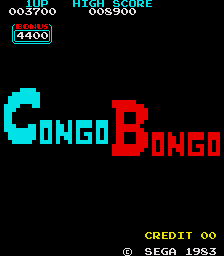Congo Bongo
| Congo Bongo Tip Top | |
|---|---|
 | |
| Developer(s) | Sega |
| Publisher(s) | Sega |
| Platform(s) | Arcade, ColecoVision, Atari 5200, Atari 8-bit, IntelliVision, Atari 2600, TI-99/4A, Commodore VIC-20, Commodore 64, DOS |
| Release date(s) | 1983 |
| Genre(s) | Isometric platformer |
| Mode(s) | Up to 2 players, alternating turns |
| Cabinet | Upright |
| Arcade system | Z80 CPU @ 3.072 MHz Z80 CPU @ 2 MHz SN76489 audio @ 4 MHz |
| Display | Raster, standard resolution (Used: 256 x 224 / Vertical) Palette Colors 256 |
Congo Bongo (J: Tip Top (ティップタップ Tippu Tappu)) is an isometric platform arcade game released by Sega in 1983. The game has come to be seen as Sega's answer to the highly successful Donkey Kong game that was released two years prior. The player takes the role of a red-nosed safari hunter who tries to catch an ape named "Bongo". The hunter seeks Bongo to exact revenge for an apparent practical joke in which Bongo set fire to the hunter's tent, giving him a literal "hotfoot". The game was named by Peter W. Gorrie[citation needed] who was the CFO of Sega at that time.
Analysis of the game's ROM code indicates that it was very likely coded at least in part by the company Ikegami Tsushinki.[1][2][3]
Gameplay
Congo Bongo's gameplay is similar to other popular arcade games of the time, most notably Frogger and Donkey Kong, but is viewed in an isometric perspective, or oblique perspective in some versions. The protagonist has no offensive abilities and thus, the player must jump to avoid enemies (and obstacles) to complete a level.
Levels
Like Donkey Kong, the levels are composed of a series of four single screens that loop in a higher difficulty when completed.
Screen 1: Primate Peak – This level most resembles Donkey Kong; the player must travel to the top of a hill while avoiding coconuts being thrown by a large gorilla. Also walking around the level are several small monkeys who attempt to grab the player. They can be shaken off by jumping in place, but if three of these monkeys attach to the player, the protagonist will be thrown off the cliff face.
Screen 2: Snake Lake – This level contains a grassland that is connected to a series of square platforms with thin pathways between. The player must avoid scorpions on the grass, snakes on the platform, and time movement with hippos in order to complete the level.
Screen 3: Rhino Ridge – This level takes place in a wide-open savanna environment where the player needs navigates around rhinos, charging in different directions. Oddly enough, stepping in the puddles will result in death, but the player can hide in the empty holes. The rhinos can also be jumped over.
Screen 4: Lazy Lagoon – This level closely resembles Frogger, as the player must cross a body of water by walking on and off various lily pads, logs, hippos, and large fish.
Legacy

Despite being a commercial failure when it was initially released [4] Congo Bongo has been ported to nearly every major gaming platform of the day, including SG-1000, MSX, Intellivision,[5] ColecoVision, Commodore 64 (twice - by Sega in 1983 and by U.S. Gold in 1985), IBM PC, Atari 2600, Atari 5200 and Atari 8-bit computers. Sega's ports for the Atari 2600, 5200, 8-bits and the C-64 featured only two of the four levels from the arcade original, while the ColecoVision release is missing the level "Snake Lake". The Intellivision port features all 4 of the game's original levels. An emulated version of the original arcade release is featured as an unlockable in the PlayStation Portable version of the Sega Genesis Collection (Sega Mega Drive Collection in PAL regions). This version was also featured in Sonic's Ultimate Genesis Collection (Sega Mega Drive Ultimate Collection in PAL regions) for Xbox 360 and PlayStation 3. Recently, an enhanced remake was released for the PlayStation 2 under the Sega Ages label as Sega Ages 2500 Vol 23: Sega Memorial Collection.
References
- ↑ Ikegami Tsushinki
- ↑ ドンキーコング裁判についてちょこっと考えてみる Thinking a bit about Donkey Kong, accessed 2009-02-01
- ↑ It started from Pong (それは『ポン』から始まった : アーケードTVゲームの成り立ち sore wa pon kara hajimatta: ākēdo terebi gēmu no naritachi), Masumi Akagi (赤木真澄 Akagi Masumi), Amusement Tsūshinsha (アミューズメント通信社 Amyūzumento Tsūshinsha), 2005, ISBN 4-9902512-0-2.
- ↑ According to "Video Games Go Crunch!" in TIME magazine October 17, 1983 issue, Congo Bongo was a commercial failure initially,
- ↑ Intellivision Rarity Guide
External links
- Congo Bongo at the Killer List of Videogames
- Congo Bongo at MobyGames
- Congo Bongo at Phosphor Dot Fossils
- Congo Bongo guide at StrategyWiki